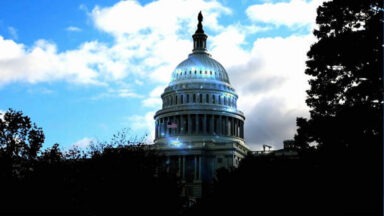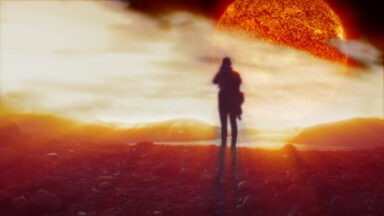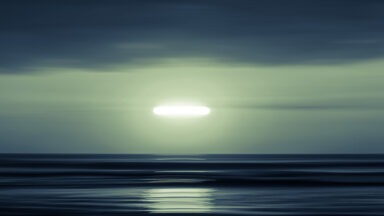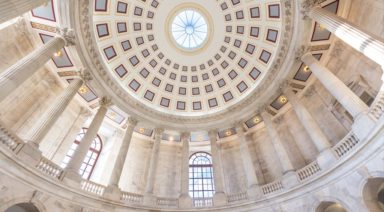Scientists Find More Mysterious Repeater Signals From Deep Space

Another set of mysterious “fast radio bursts” (FRBs) from a distant galaxy were recorded by astronomers at the Canadian Hydrogen Intensity Mapping Experiment (CHIME) in British Columbia. Scientists are still unsure of the source of these strange bursts, though one potential explanation posits that they may be the product of an advanced alien civilization.
The latest bursts are the first recorded from this source since it was accidentally discovered in 2007. Astronomers remain baffled by this latest recording, which detailed signals at a significantly lower frequency than their first discovery. Initial frequencies clocked in at 1,400 megahertz, but the latest bursts came in at around 400 MHz; the lowest possible frequency their instruments could detect.
Is this potential alien civilization sending signals at varying ranges to increase its chances of being heard? If so, it seems we’re picking up all of them.
Though they were first discovered in 2007, speculation around the FRBs’ origin didn’t captivate headlines as much as it did in 2017 when Professor Avi Loeb of the Harvard-Smithsonian Center for Astrophysics published a paper suggesting the alien possibility.
“Fast radio bursts are exceedingly bright given their short duration and origin at great distances, and we haven’t identified a possible natural source with any confidence,” Loeb said. “An artificial origin is worth contemplating and checking.”
There are two competing theories on the extraterrestrial potential; the first being that a civilization is transmitting their calling card in hopes of contacting another civilization like ourselves. The other possibility is that the bursts are propelling the sails of alien probes in deep space – a type of technology the Breakthrough Initiative is currently attempting to develop.
Astronomers noticed that whatever the source of these waves may be, it’s scattering the radio bursts – meaning it must be a massive object with “special characteristics.”
“That could mean in some sort of dense clump like a supernova remnant or near the central black hole in a galaxy,” said Dr Cherry Ng, a team member in the study from the University of Toronto. “But it has to be in some special place to give us all the scattering that we see.”
In the event that these bursts are coming from an alien megastructure, their source would likely have to be at least the size of a planet, unless they’re being emitted by some technology we can’t yet fathom. This would surely put the civilization beyond level one on the Kardashev scale, a level in which they have been able to harness all the energy of their home planet. We, on the other hand, have yet to reach such advancement.
Could this latest discovery mean we’re on the precipice of making contact with an advanced extraterrestrial civilization? It might be time to start building an intergalactic radio broadcaster of our own…
Harvard Professor Avi Loeb Says Universe Created in a Lab

One of the greatest mysteries of our universe is the question of what existed before the Big Bang and how our universe was created. Could it have been created in a lab by a higher form of intelligence—an extraterrestrial intelligence?
Scientists have studied for years the possibilities that may have created the Big Bang; how our universe was created. Now, Avi Loeb, Harvard Professor of Science and author of “extraterrestrial: The First Sign of Intelligent Life Beyond Earth,” proposes in his latest editorial for Scientific American that our universe may have been created in a lab.
Modern physics has a problem, we do not yet have a good understanding of how to unify quantum mechanics and gravity. If we did, we could in theory figure out how to create a “Big Bang.” This idea led professor Loeb to his theory.
“If we imagine a civilization that had science and technology for much more than a century like we did, then they could have arrived at a theory that unifies quantum mechanics and gravity, and if they figure out how the Big Bang can be created perhaps they could also produce it themselves in the laboratory,” Loeb said. “And if that happens then there is a very interesting possibility, just like in nature, for example, a chick comes out of an egg, becomes a chicken and lays another egg, and so forth. You can imagine a universe like ours giving birth to an intelligent civilization that can create a universe like the one that made it.”
Imagine if different civilizations were given a letter grade; professor Loeb puts us at a Grade C, while the more advanced civilizations have higher grades.
“One can, in principle, classify civilizations in the universe into different classes. Type C civilization is similar to ours where we rely on the sun to keep us alive and we are using our environment the way it was provided to us. But then one can imagine a civilization Type B, which is not dependent on the star next to which it was born, in. fact it can create a habitat that supports its life far away from the star,” Loeb said.
“You can imagine them creating a platform where a civilization can live happily, using nuclear energy supplied to it from nuclear reactors and not from the star that it happens to be born next to, that would be Type B. Then Type A civilizations would be those that are capable of recreating the astrophysical environment that they live in, in particular, the universe as a whole. So, creating a universe in the laboratory implies that you’re at the top of the class of civilizations in the universe. We haven’t reached that yet because we don’t have a quantum theory of gravity.”




































